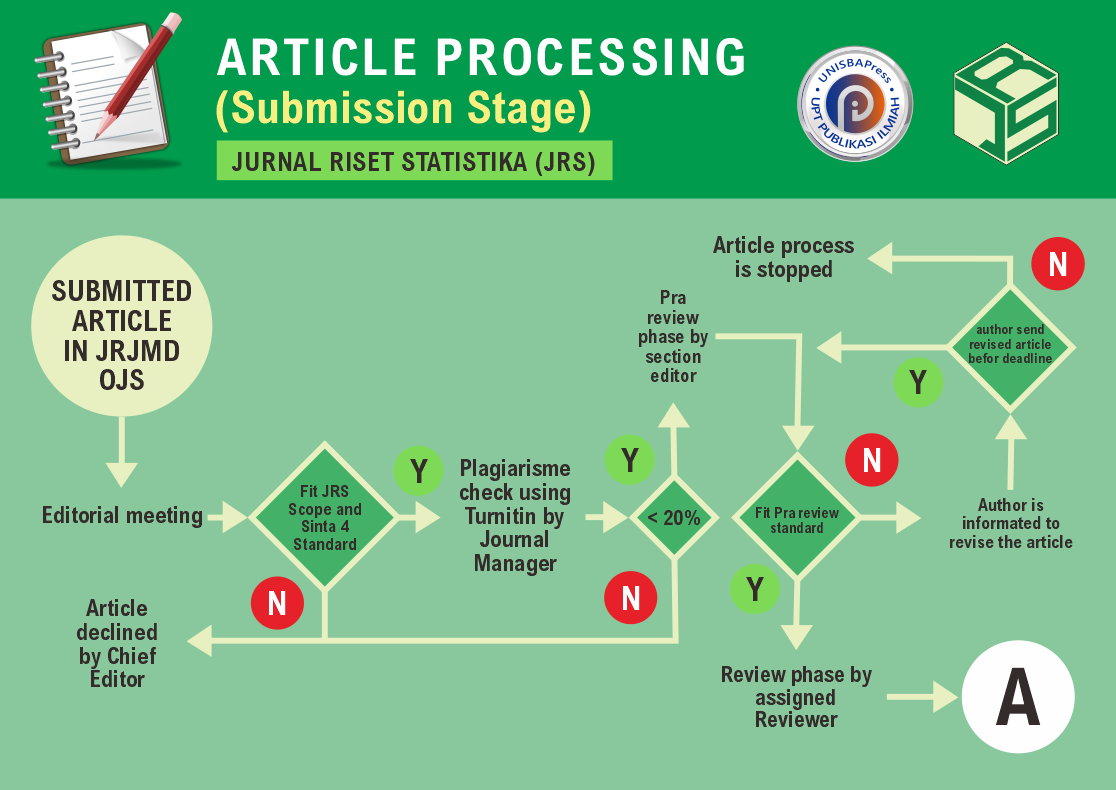Model Random Coefficient Autoregressive Orde Pertama dan Penerapannya
DOI:
https://doi.org/10.29313/jrs.v3i2.3048Keywords:
Deret Waktu, Random Coefficient Autoregressive, PeramalanAbstract
Abstract. The data used for forecasting using the RCA (1) model must have a stationary pattern or be around the average. However, most economic data has volatility properties, which means that it describes large changes in either the increase or decrease in the object measured in a certain period of time such as in data on gold prices, stock prices and so on. In conditions of volatility data, the RCA(1) model can work very well in forecasting because large changes in the value of the variable cause the size of the variance in the variable to move randomly over time. The purpose of this research is to see the forecasting results and the level of accuracy in forecasting the daily gold price in 2023 based on the RCA(1) model. In the analysis results, the parameter estimation value in the RCA(1) model is BLUE (Best Linear Unbiased Estimator) because all assumptions in the Ordinary Least Square (OLS) method are met. In addition, it is also evident that the volatility of the data causes the estimated value of the variance of the coefficient to move away from zero. Then, the forecasting value using the RCA(1) model has a high accuracy rate of 3.86% which is calculated through the Mean Absolute Percentage Error (MAPE). This means that the RCA(1) model works very well for forecasting short and volatile time series data. And it can be seen for the forecast of 1 day ahead that is on May 17, 2023 at $1994,71/Ons where the price of gold has fallen from the day before.
Abstrak. Data yang digunakan untuk melakukan peramalan menggunakan model RCA(1) harus memiliki pola yang stasioner atau berada disekitar rata-rata. Namun, sebagian besar data ekonomi memiliki sifat volatilitas yang artinya menggambarkan perubahan besar baik kenaikan atau penurunan pada objek yang diukur dalam periode waktu tertentu seperti pada data harga emas, harga saham dan lain sebagainya. Pada kondisi data yang bersifat volatilitas, model RCA(1) dapat bekerja sangat baik dalam peramalan karena perubahan besar nilai variabel menyebabkan ukuran varians pada variabel bergerak secara acak dari waktu ke waktu. Tujuan penelitian ini yaitu melihat hasil peramalan dan tingkat akurasi dalam meramalkan harga emas harian tahun 2023 berdasarkan model RCA(1). Dalam hasil analisis, nilai estimasi parameter pada model RCA(1) bersifat BLUE (Best Linear Unbiased Estimator) karena semua asumsi pada metode Ordinary Least Square (OLS) terpenuhi. Selain itu, terbukti pula bahwa data yang bervolatilitas menyebabkan nilai estimasi varians dari koefisien menjauhi nilai nol. Kemudian, nilai peramalan menggunakan model RCA(1) memiliki nilai tingkat akurasi yang tinggi yaitu sebesar 3.86% yang dihitung melalui Mean Absolute Percentage Error (MAPE). Artinya, model RCA(1) bekerja sangat baik untuk peramalan data deret waktu singkat dan bervolatilitas. Dan terlihat untuk peramalan 1 hari kedepan yaitu pada tanggal 17 Mei 2023 sebesar 1994.71 USD/Ons dimana harga emas mengalami penurunan dari hari sebelumnya.
References
Ashari, “Penerapan Metode Times Series Dalam Simulasi Forecasting Perkembangan Akademik Mahasiswa,” Stmikakba, vol. 2, no. 1, pp. 9–16, 2012.
M. Nurhidayati, “Estimasi Parameter Model Autoregressive dengan Metode Yule Walker, Least Square, dan Maximum Likelihood (Studi Kasus Data ROA BPRS di Indonesia),” Quadratic: Journal of Innovation and Technology in Mathematics and Mathematics Education, vol. 1, no. 1, pp. 1–6, 2021, doi: 10.14421/quadratic.2021.011-01.
M. Ariefianto, Ekonometrika Esensi dan Aplikasi dengan Menggunakan Eviews. Erlangga, 2012.
M. Regis, P. Serra, and E. R. van den Heuvel, “Random autoregressive models: A structured overview,” Econometric Reviews, vol. 41, no. 2, pp. 207–230, 2022, doi: 10.1080/07474938.2021.1899504.
D. F. & B. G. Q. Nicholls, “THE ESTIMATION OF RANDOM COEFFICIENT AUTOREGRESSIVE MODELS. I,” JOURNAL OF TIME SERIES ANALYSIS, vol. 1, no. 1, pp. 37–46, 1980, doi: 0143-9782/80/010037-10.
A. Araveeporn, “A Comparison of Parameter Estimation Methods for the First-Order of Random Coefficient Autoregressive Model,” Thailand Statistician, vol. 20, no. 4, pp. 892–904, 2022.
Rusdi, “Uji Akar-Akar Unit dalam Model Runtun Waktu Autoregresif,” Satistika, vol. 11, no. 2, pp. 67–78, 2011.
A. E. & K.-S. C. Raftery, Time series analysis with Applications in R, 2nd ed., vol. 20, no. 2. Iowa: Springer, 1985. doi: 10.1016/0377-2217(85)90052-9.
N. Hanifah, N. Herrhyanto, and F. Agustina, “Penerapan Metode Weigthed Least Square Untuk Mengatasi Heteroskedastisitas Pada Analisis Regresi Linear,” Jurnal EurekaMatika, vol. 3, no. 1, pp. 105–114, 2015.
M.-H. Cheng, Y.-C. Wu, and M.-C. Chen, “Television Meets Facebook: The Correlation between TV Ratings and Social Media,” American Journal of Industrial and Business Management, vol. 06, no. 03, pp. 282–290, 2016, doi: 10.4236/ajibm.2016.63026.













